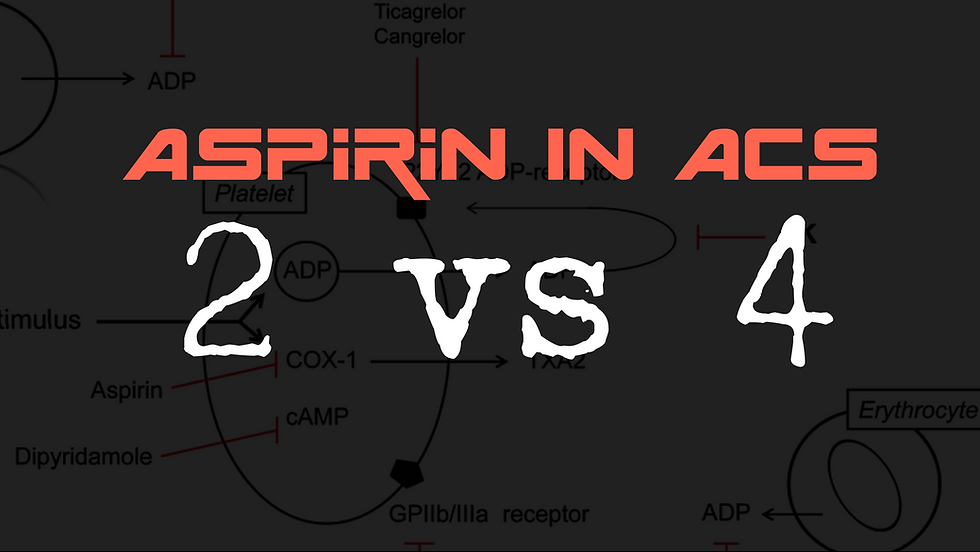Podcast 54 - Approaching The Shocky Patient In Afib RVR w/ Josh Farkas
- Tyler Christifulli
- Aug 14, 2018
- 3 min read

Occasionally we find ourself asking..
Is the hypotension being caused by the rate?
Is the rate compensating for the hypotension?
I reached out to Josh Farkas from PulmCrit (EMcrit) in hopes he would help me come up with an algorithm or mental-flow that could be used to formulate a decision when faced with this situation. Josh put out a primer blog on PulmCrit to get some opinions of the providers amongst the Twitter realm before our podcast discussion.
Whats The Actual Rate?
As we are aware, atrial fibrillation rates can vary with every glance at the monitor. There is a tendency to only see the high rates and mentally exclude the ones between. Sometimes it helps to calculate an average rate based off a six second strip.

I believe up until the 130-150 bpm mark in the presence of hypotension, many of us believe the rate to be compensatory. However, this will depend on the onset, history, and underlying co-morbidities. When hemodynamic instability is present we have to answer this question in a timely manner.


New Onset AF
If a patient who is typically in a sinus rhythm converts to atrial fibrillation, and then becomes hypotensive, cardioversion is the fastest and safest option. The AHA recommends starting cardioverting between 120-200 joules. Josh and I both agree that its usually more efficient to start off at 200 joules, rather than starting low and working your way up and possibly out of sedation coverage (#EtomidateProbs).
To optimize atrial depolarization Vince DiGiulio (@MedicalApproach) pointed out a right parasternal A/P pad placement. This is recommended by Zoll as well.


Chronic AF
When patients with chronic AF get sick or hypotensive they respond the same way a person with a sinus rhythm would.. by increasing their rate. RVR is just their flavor of sinus tach and therefore should not be presumed to be the issue until it probably gets into the >150 range. AF already reduces cardiac output by losing atrial kick. If rate increases beyond therapeutic range, you are met with diminishing returns of both benefits and diastolic filling.
Once you pull the trigger on controlling the rate, its important to remember slower is not always better. A rate of 60-100 is probably not normal for someone who is septic or hypotensive. What is the ideal rate? We have no clue. Josh says his goal is probably somewhere <130. This will most likely differ amongst patient populations.

Amiodarone (most popular)
During phase three of the myocytes action potential, potassium leaves the cell and brings the voltage down to baseline. If we block (slow down) the potassium from leaving the cell, we will prolong the effective refractory period. While amiodarone is classified in the Vaughan-Williams Class iii category(potassium blockers), it works on sodium and calcium channels as well. Amio has little to no effect on vasculature and is very specific to the myocytes. This is why I believe it is preferred in these presentations. It is often taught that amiodarone has an extremely long half life. This is true when taken chronically, but a single loading dose will leave your system within 18-36 hrs. If first loading dose doesn't do the trick.. try another.

Digoxin
Digoxin works by inhibiting the sodium/potassium pump. This pump is necessary for the action potential to maintain its concentration gradient. When this pump is inhibited it causes the intracellular sodium to rise. The rise in intracellular sodium will cause the sodium/calcium exchanger to trade three sodium ions for one calcium ion. This mechanism will increase intracellular calcium levels and increase strength of contraction. Digitalis will increase efferent vagal stimulation to the heart and reduce conduction via the AV node.

Magnesium
Josh did a fantastic blog on the use of magnesium for rate control in atrial fibrillation. Magnesium is a natural calcium channel blocker. It will inhibit the ionic movement through the L-type calcium channels. AV nodal conduction is most sensitive to calcium channel blockades. This will be seen in phase 0 of the pacemaker action potential. When discussing this with colleagues, I often hear "are you suppose to check their magnesium levels prior to starting this?" It's important to understand that serum magnesium levels represent less than a 1% of intracellular concentration. Magnesium is also poorly absorbed before its secreted through the urine. This technique for rate control appears to be relatively safe with or dependent of amiodarone therapy.

Proposed Algorithm


Josh Farkas
Dr. Farkas is an assistant professor of Pulmonary and Critical Care Medicine at the University of Vermont (Burlington Vermont, USA). His training consists of medical school at Cornell University followed by Internal Medicine residency at Dartmouth University and a Pulmonary and Critical Care fellowship at Albany Medical Center.
Additional Reading:




